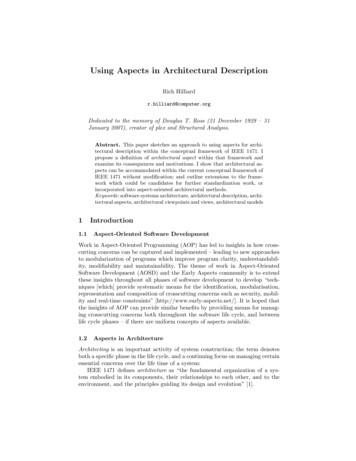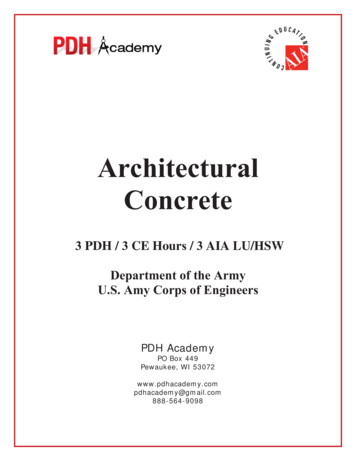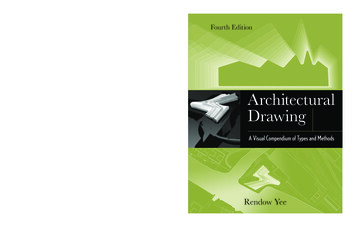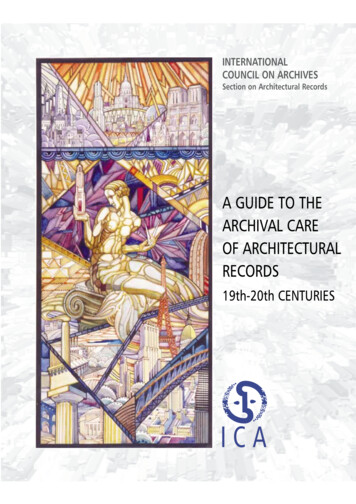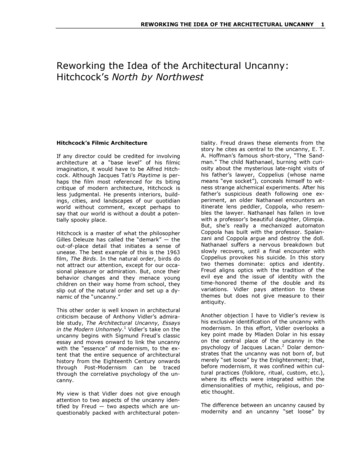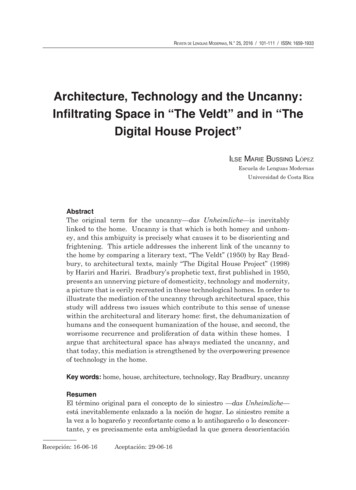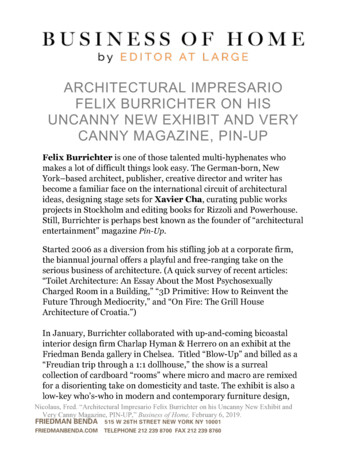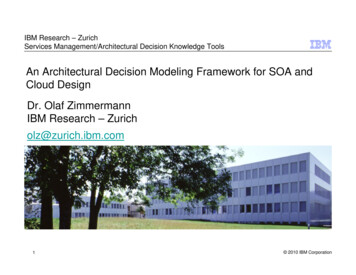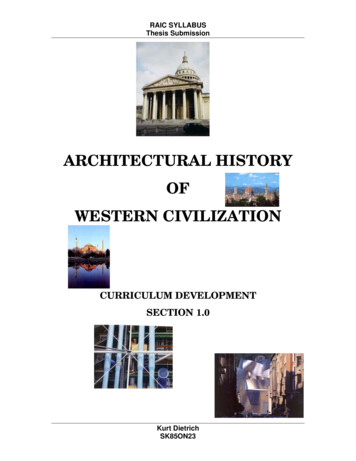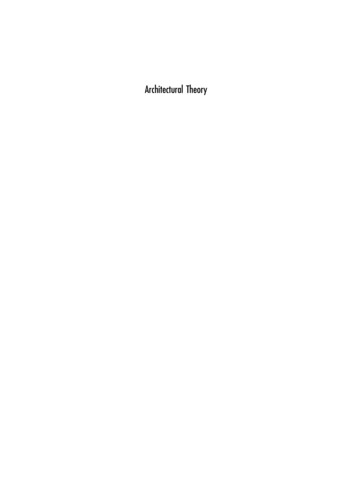
Transcription
Mallgrave / Architectural 1405102578 1 pretoc Final Proof page iArchitectural Theory13.6.2005 10:18pm
Mallgrave / Architectural1405102578 1 pretocFinal Proof page ii 13.6.200510:18pm
ARCHITECTURAL THEORYVolume IAn Anthology from Vitruvius to 1870Edited by Harry Francis Mallgrave
Mallgrave / Architectural 1405102578 1 pretocFinal Proof page iv13.6.2005 10:18pmEditorial material and organization ß 2006 by Harry Francis MallgraveBLACKWELL PUBLISHING350 Main Street, Malden, MA 02148-5020, USA9600 Garsington Road, Oxford OX4 2DQ, UK550 Swanston Street, Carlton, Victoria 3053, AustraliaThe right of Harry Francis Mallgrave to be identified as the Author of the Editorial Material in this Workhas been asserted in accordance with the UK Copyright, Designs, and Patents Act 1988.All rights reserved. No part of this publication may be reproduced, stored in a retrieval system, ortransmitted, in any form or by any means, electronic, mechanical, photocopying, recording or otherwise,except as permitted by the UK Copyright, Designs, and Patents Act 1988, without the prior permission ofthe publisher.First published 2006 by Blackwell Publishing Ltd12006Library of Congress Cataloging-in-Publication DataArchitectural theory, volume I: an anthology from Vitruvius to 1870 /edited by Harry Francis Mallgrave.p. cm.Includes bibliographical references and index.ISBN-13: 978-1-4051-0257-5 (hard cover : alk. paper)ISBN-10: 1-4051-0257-8 (hard cover : alk. paper)ISBN-13: 978-1-4051-0258-2 (pbk. : alk. paper)ISBN-10: 1-4051-0258-6 (pbk. : alk. paper)1. Architecture–Philosophy. I. Mallgrave, Harry Francis.NA2500.A7115 2005720’.1–dc222004030886A catalogue record for this title is available from the British Library.Set in 10/13pt Danteby SPI Publisher Services, Pondicherry, IndiaPrinted and bound in the United Kingdomby TJ International Ltd, Padstow, CornwallThe publisher’s policy is to use permanent paper from mills that operate a sustainable forestry policy, andwhich has been manufactured from pulp processed using acid-free and elementary chlorine-free practices.Furthermore, the publisher ensures that the text paper and cover board used have met acceptableenvironmental accreditation standards.For further information onBlackwell Publishing, visit our website:www.blackwellpublishing.com
Mallgrave / Architectural 1405102578 2 tocFinal Proofpage v14.6.20059:31amCONTENTSxxiPrefacexxiiiGeneral IntroductionPart I:Classicism and the Renaissance1A. The Classical and Medieval Traditions3Introduction31.2.3.4.Vitruviusfrom On Architecture, Book 1 (c.25Vitruviusfrom On Architecture, Book 2 (c.25BC)BC)Vitruviusfrom On Architecture, Book 4 (c.25BC)Old Testamentfrom I Kings6.Old Testamentfrom The Book of Ezekiel (c.5868.9Vitruviusfrom On Architecture, Book 3 (c.255.7.5BC)11121518BC)New Testamentfrom The Revelation of Jesus Christ to Saint John (c.95Abbot Sugerfrom The Book of Suger, Abbot of Saint-Denis (c.1144)20AD)22
Mallgrave / Architectural9.1405102578 2 toc Final Proof page vi 14.6.2005 9:31amWilliam Durandusfrom The Symbolism of Churches and Church Ornaments (1286)24B. Renaissance and Baroque Ideals26Introduction2610.Antonio di Tuccio Manettifrom The Life of Brunelleschi (1480s)2811.Leon Battista Albertifrom On the Art of Building, Prologue and Book I (1443–52)3012.Leon Battista Albertifrom On the Art of Building, Book 6 (1443–52)3213.Leon Battista Albertifrom On the Art of Building, Book 9 (1443–52)3414.Il Filaretefrom Book 1 of his untitled treatise on architecture (1461–3)3615.Il Filaretefrom Book 8 of his untitled treatise on architecture3916.Sebastiano Serliofrom Book 3, The Complete Works on Architecture and Perspective (1540)4217.Giacomo Barozzi da Vignolafrom Preface to Rules of the Five Orders of Architecture (1562)4418.Palladiofrom The Four Books of Architecture (1570)4619.Juan Bautista Villalpandofrom Ezekiel Commentaries (1604)4820.Georgio Vasarifrom Preface to Lives of the Most Eminent Italian Architects, Painters,and Sculptors (1550, 1568)5021.Georgio Vasarifrom ‘‘Life of Michelangelo’’ in Lives of the Most Eminent Italian Architects,Painters, and Sculptors (1550, 1568)5322.Peter Paul Rubensfrom Preface to Palaces of Genoa (1622)55VIC ON T EN T S
Mallgrave / Architectural 1405102578 2 tocFinal Proof page vii 14.6.20059:31amPart II: Classicism in France and Britain57A. French Classicism: Ancients and Moderns59Introduction5923.René Descartesfrom Rules for the Direction of the Mind (1628)6124.Roland Fréart de Chambrayfrom Preface to A Parallel of the Ancient Architecture with the Modern (1650)6225.Paul Fréart de Chanteloufrom Diary of the Cavaliere Bernini’s Visit to France (1665)6526.François Blondelfrom ‘‘Inaugural Lecture to the Academy of Architecture’’ (1671)7027.François Blondel,from Architecture Course (1675)7228.René Ouvrardfrom Harmonic Architecture (1677)7229.Claude Perraultannotations to French translation of The Ten Books of Architecture ofVitruvius (1673)7430.François Blondelfrom Architecture Course, Vol. II (1683)7631.Claude Perraultfrom The Ten Books of Architecture of Vitruvius, second edition (1684)7732.Claude Perraultfrom Ordonnance for the Five Kinds of Columns After the Method of theAncients (1683)7833.Jean-François Félibienfrom Preface to Historical Survey of the Life and Works of the Most CelebratedArchitects (1687)8134.Charles Perraultfrom Preface to Parallel of the Ancients and Moderns with Regard to the Artsand Sciences (1688)8235.Charles Perraultfrom ‘‘Design of a Portal for the Church of Sainte-Geneviève in Paris’’ (1697)8336.Michel de Fréminfrom Critical Memoirs on Architecture (1702)84CO N TE N TSVII
Mallgrave / Architectural37.1405102578 2 toc Final Proofpage viii 14.6.20059:31amJean-Louis de Cordemoyfrom New Treatise on All Architecture or the Art of Building (1706, 1714)86B. British Classicism and Palladianism88Introduction8838.Henry Wottonfrom The Elements of Architecture (1624)8939.Christopher Wrenfrom Tract I on architecture (mid-1670s)9140.Christopher Wrenfrom Tracts II and IV on architecture (mid-1670s)9341.Anthony Ashley Cooper, Third Earl of Shaftesburyfrom Characteristics of Men, Manners, Opinions, Times (1711)9442.Anthony Ashley Cooper, Third Earl of Shaftesburyfrom ‘‘A Letter Concerning Design’’ (1712)9843.Colin CampbellIntroduction to Vitruvius Britannicus, Vol. I (1715)10144.Nicholas Du BoisTranslator’s Preface to The Architecture of A. Palladio (1715)10345.William Kent‘‘Advertisement’’ to The Designs of Inigo Jones (1727)10646.James GibbsIntroduction to A Book of Architecture (1728)10747.Robert Morrisfrom An Essay in Defence of Ancient Architecture (1728)10948.Alexander Popefrom Of False Taste (1731)11249.Isaac Ware‘‘Advertisement’’ to Andrea Palladio: The Four Books of Architecture (1737)11450.Robert Morrisfrom ‘‘An Essay upon Harmony’’ (1739)115VIIIC ON T EN T S
Mallgrave / Architectural 1405102578 2 tocFinal Proofpage ix 14.6.20059:31amPart III: Neoclassicism and the Enlightenment119A. Early Neoclassicism121Introduction12151.Johann Bernhard Fischer von Erlachfrom Preface to Outline for a Historical Architecture (1721)12252.Voltairefrom Philosophic Letters on the English (1733)12353.Jacques-Gabriel Soufflotfrom ‘‘Memoir on Architectural Proportions’’ (1739)12554.Jacques-Gabriel Soufflotfrom ‘‘Memoir on Gothic Architecture’’ (1741)12655.Carlo Lodolifrom Notes for a projected treatise on architecture (c.1740s)12756.Baron de Montesquieufrom Preface to The Spirit of the Laws (1748)13057.Jean-Jacques Rousseaufrom ‘‘Discourse on the Sciences and Arts’’ (1750)13258.Jean Le Rond D’Alembertfrom ‘‘Preliminary Discourse of the Editors’’ (1751)13559.Jacques-François Blondelfrom ‘‘Architecture’’ in Diderot’s Encyclopedia (1751)13860.Charles-Étienne Briseuxfrom Preface to Treatise on Essential Beauty in the Arts (1752)14061.Marc-Antoine Laugierfrom Essay on Architecture (1753)14162.Marc-Antoine Laugierfrom Essay on Architecture (1753)14463.Isaac Warefrom A Complete Body of Architecture, Chapter II (1756)14764.Isaac Warefrom A Complete Body of Architecture, Chapter IX (1756)14865.William Chambersfrom A Treatise on Civil Architecture (1759)15066.William Chambersfrom A Treatise on the Decorative Part of Civil Architecture (1791)152CO NTE N TSIX
Mallgrave / Architectural 1405102578 2 tocFinal Proofpage x 14.6.20059:31amB. Greece and the Classical Ideal154Introduction15467.James Stuart and Nicholas Revettfrom ‘‘Proposals for publishing an accurate description ofthe Antiquities of Athens’’ (1748)15568.Robert Wood and James Dawkinsfrom The Ruins of Palmyra (1753)15869.Johann Joachim Winckelmannfrom Reflections on the Imitation of Greek Works in Painting and Sculpture (1755)15970.Allan Ramsayfrom ‘‘A Dialogue on Taste’’ in The Investigator (1755)16371.Julien-David Le Royfrom The Ruins of the Most Beautiful Monuments of Greece (1758)16572.Julien-David Le Royfrom The Ruins of the Most Beautiful Monuments of Greece (1758)16873.James Stuart and Nicholas Revettfrom Preface to The Antiquities of Athens (1762)16974.Johann Joachim Winckelmannfrom History of the Art of Antiquity (1764)17275.Johann Joachim Winckelmannfrom History of the Art of Antiquity (1764)17476.Johann Joachim Winckelmannfrom History of the Art of Antiquity (1764)17677.Giovanni Battista Piranesifrom ‘‘Observations on the Letter of Monsieur Mariette’’ (1765)17878.Giovanni Battista Piranesifrom Opinions on Architecture (1765)18579.Giovanni Battista Piranesifrom ‘‘An Apologetical Essay in Defence of the Egyptian andTuscan Architecture’’ (1769)188C. Character and Expression190Introduction19080.Germain Boffrandfrom Book of Architecture (1745)191XC ON T EN T S
Mallgrave / Architectural1405102578 2 toc Final Proof page xi14.6.2005 9:31am81.Étienne Bonnot de Condillacfrom Essay on the Origin of Human Knowledge (1746)19382.Julien-David Le Royfrom History of the Arrangement and Different Forms that the ChristiansHave Given to Their Churches (1764)19583.Jacques-François Blondelfrom Course of Architecture (1771)19784.Nicolas Le Camus de Mézièresfrom The Genius of Architecture (1780)19985.Nicolas Le Camus de Mézièresfrom The Genius of Architecture (1780)20186.Jean-Louis Viel de Saint-Mauxfrom Letters on the Architecture of the Ancients and the Moderns (1787)20487.A. C. Quatremère de Quincyfrom Methodical Encyclopedia (1788)20688.Étienne-Louis Boulléefrom Architecture, Essay on Art (c.1794)21089.Étienne-Louis Boulléefrom Architecture, Essay on Art (c.1794)21390.Claude Nicolas Ledouxfrom Architecture Considered in Relation to Art, Morals, and Legislation (1804)21691.John Soanefrom Royal Academy Lectures on Architecture (V and XI; 1812–15)218Part IV: Theories of the Picturesque and the Sublime221A. Sources of the Picturesque223Introduction22392.John Lockefrom An Essay Concerning Human Understanding (1690)22493.William Templefrom ‘‘Upon the Gardens of Epicurus; or, of Gardening in theYear 1685’’ (1692)22994.John Vanbrughfrom Letter to the Duchess of Marlborough (1709)23095.Anthony Ashley Cooper, Third Earl of Shaftesburyfrom ‘‘The Moralists’’ (1709)232CO NTE N TSXI
Mallgrave / Architectural 1405102578 2 tocFinal Proofpage xii 14.6.20059:31am96.Joseph Addisonfrom The Spectator (1712)23497.Robert Castellfrom The Villas of the Ancients Illustrated (1728)23998.Batty Langleyfrom New Principles of Gardening (1728)24199.Robert Morrisfrom Lectures on Architecture (1736)243William Chambersfrom Designs of Chinese Buildings (1757)245100.B. Toward a Relativist Aesthetics249Introduction249101.John Lockefrom An Essay Concerning Human Understanding, fourth edition (1700)250102.Joseph Addisonfrom The Spectator (1712)253103.Jean Baptiste du Bosfrom Critical Reflections on Poetry, Painting, and Music (1719)256104.Francis Hutchesonfrom An Inquiry into the Original of our Ideas of Beauty and Virtue (1725)258105.George Berkeleyfrom the ‘‘Third Dialogue’’ of Alciphron (1732)261106.David Humefrom A Treatise of Human Nature (1739–40)266107.Allan Ramseyfrom ‘‘A Dialogue on Taste’’ in The Investigator (1755)267108.Alexander Gerardfrom An Essay on Taste (1756)269109.David Humefrom ‘‘Of the Standard of Taste’’ (1757)271110.Edmund Burkefrom A Philosophical Inquiry into the Origin of our Ideas of the Sublimeand Beautiful (1757)273111.Edmund Burkefrom A Philosophical Inquiry into the Origin of our Ideas of the Sublimeand Beautiful (1757)277XIIC ON T EN T S
Mallgrave / Architectural1405102578 2 toc Final Proofpage xiii 14.6.20059:31am112.Lord Kamesfrom Elements of Criticism (1762)284113.Robert and James Adamfrom Preface to The Works in Architecture of Robert and James Adam (1773–8)286C. Consolidation of Picturesque Theory290Introduction290114.Thomas Whatelyfrom Observations on Modern Gardening (1770)291115.Horace Walpolefrom ‘‘The History of the Modern Taste in Gardening’’ (1771)295116.William Chambersfrom A Dissertation on Oriental Gardening (1772)298117.William Gilpinfrom Observations on the River Wye (1782)300118.Joshua Reynoldsfrom Discourses on Art (1786)303119.John Soanefrom Plans, Elevations, and Sections of Buildings (1788)305120.Uvedale Pricefrom Essays on the Picturesque (1794)307121.Richard Payne Knightfrom ‘‘Postscript’’ to The Landscape, second edition (1795)312122.Humphry Reptonfrom Sketches and Hints on Landscape Gardening (1795)316123.Uvedale Pricefrom ‘‘An Essay on Architecture and Buildings as connected withScenery’’ (1798)319124.Richard Payne Knightfrom An Analytical Inquiry into the Principles of Taste (1805)322125.John Soanefrom Royal Academy Lectures on Architecture, V, VIII, and XI (1812–15)325C ON T EN T SXIII
Mallgrave / Architectural1405102578 2 toc Final Proof page xiv14.6.2005 9:31amPart V: The Rise of Historicism in the Nineteenth Century331A. Challenges to Classicism in France, 1802–34333Introduction333126.Jean-Nicolas-Louis Durandfrom Précis of the Lectures on Architecture (1802)334127.A. C. Quatremère de Quincyfrom On Egyptian Architecture (1803)338128.Christian Ludwig Stieglitzfrom Archaeology of the Architecture of the Greeks and Romans (1801)340129.A. C. Quatremère de Quincyfrom The Olympian Jupiter (1814)341130.Charles Robert Cockerellfrom ‘‘On the Aegina Marbles’’ (1819)343131.William Kinnardannotations to Stuart and Revett’s The Antiquities of Athens,second edition (1825)344132.Otto Magnus von Stackelbergfrom The Temple of Apollo at Bassae in Arcadia (1826)345133.Jacques Ignace Hittorfffrom ‘‘Polychrome Architecture Among the Greeks’’ (1830)347134.Gottfried Semperfrom Preliminary Remarks on Polychrome Architecture and Sculpture inAntiquity (1834)348135.Léon Vaudoyerexcerpts from three letters of 1829, 1830, and 1831351136.Émile Barraultfrom To Artists (1830)353137.Victor Hugofrom The Hunchback of Notre-Dame (1832)356138.Gottfried Semperfrom Preliminary Remarks on Polychrome Architecture and Sculpture inAntiquity (1834)357139.Léonce Reynaudfrom ‘‘Architecture’’ in the New Encyclopedia (1834)359XIVCO N TE N TS
Mallgrave / Architectural 1405102578 2 tocFinal Proofpage xv 14.6.20059:31amB. The Gothic Revival in Britain, Germany, and France362Introduction362140.Horace Walpolefrom Letter to H. Zouch (1759)363141.Horace Walpolefrom A Description of the Villa of Horace Walpole at Strawberry Hill (1774)364142.Johann Wolfgang von Goethefrom ‘‘On German Architecture’’ (1772)366143.François René Chateaubriandfrom The Genius of Christianity (1802)368144.Friedrich von Schlegelfrom Notes on a Trip through the Netherlands (1806)370145.Joseph Görresfrom ‘‘The Cathedral in Cologne’’ (1814)373146.Georg Mollerfrom Monuments of German Architecture (1815–21)375147.Thomas Rickmanfrom An Attempt to Discriminate the Styles of English Architecture (1817)376148.William Whewellfrom Architectural Notes on German Churches (1830)378149.Robert Willisfrom Remarks on the Architecture of the Middle Ages (1835)381150.A. W. N. Puginfrom Contrasts (1836)383151.A. W. N. Puginfrom The True Principles of Pointed or Christian Architecture (1841)385152.John Mason Neale and Benjamin Webbfrom The Ecclesiologist (1841)386153.Victor Hugofrom The Hunchback of Notre-Dame (1832)388154.Léonce Reynaudfrom ‘‘Architecture’’ in the New Encyclopedia (1834)390155.Eugène-Emmanuel Viollet-le-Ducfrom ‘‘On the Construction of Religious Buildings in France’’ (1844)391C ON T E N T SXV
Mallgrave / Architectural1405102578 2 toc Final Proofpage xvi 14.6.20059:31amC. The German Style Debate395Introduction395156.Immanuel Kantfrom Critique of Judgment (1790)396157.August Schlegelfrom Lectures on Literature and the Fine Arts (1801–2)398158.Friedrich Gillyfrom ‘‘Some Thoughts on the Necessity of Endeavoring to Unify theVarious Departments of Architecture . . . ’’ (1799)399159.Karl Friedrich SchinkelLiterary fragments (c.1805)401160.Georg Wilhelm Friedrich Hegelfrom The Philosophy of Fine Art (1820s)403161.Friedrich von Gärtnerfrom Letter to Johann Martin von Wagner (1828)406162.Heinrich Hübschfrom In What Style Should We Build? (1828)407163.Rudolf Wiegmannfrom ‘‘Remarks on the Book: In What Style Should We Build?’’ (1829)410164.Karl Friedrich Schinkelfrom Notes for a textbook on architecture (c.1830)412165.Karl Friedrich Schinkelfrom Notes for a textbook on architecture (c.1835)414166.Rudolf Wiegmannfrom ‘‘Thoughts on the Development of a National Architectural Stylefor the Present’’ (1841)415167.Johann Heinrich Wolfffrom ‘‘Remarks on the Architectural Questions Broached by ProfessorStier. . . ’’ (1845)417168.Eduard Metzgerfrom ‘‘Contribution to the Contemporary Question: In What Style ShouldOne Build!’’ (1845)419169.Carl Bötticherfrom ‘‘The Principles of the Hellenic and Germanic Ways of Building’’ (1846)421XVICO N TE N TS
Mallgrave / Architectural 1405102578 2 toc Final Proof page xvii 14.6.20059:31amD. The Rise of American Theory425Introduction425170.Thomas JeffersonLetters (1787, 1791, 1805, 1810)426171.Benjamin Latrobefrom Letter to Thomas Jefferson (1807)432172.George Tuckerfrom ‘‘On Architecture’’ (1814)435173.William Stricklandfrom Introductory lecture on architecture (1824)437174.Thomas U. Walterfrom ‘‘Of Modern Architecture’’ (1841)439175.Arthur Delavan Gilmanfrom ‘‘Architecture in the United States’’ (1844)440176.Thomas Alexander Tefftfrom ‘‘The Cultivation of True Taste’’ (1851)443177.Ralph Waldo Emersonfrom ‘‘Self-Reliance’’ (1841)444178.Ralph Waldo Emersonfrom ‘‘Thoughts on Art’’ (1841)446179.Horatio Greenoughfrom Letter to Washington Allston (1831)449180.Horatio Greenoughfrom ‘‘American Architecture’’ (1843)452181.Horatio Greenoughfrom ‘‘Structure and Organization’’ (1852)454182.Henry David Thoreaufrom his journal ( January 11, 1852)456183.Andrew Jackson Downingfrom A Treatise on the Theory and Practice of Landscape Gardening (1841)457184.Andrew Jackson Downingfrom Cottage Residences (1842)460185.Andrew Jackson Downingfrom Hints to Persons about Building in the Country (1847)462C ON T EN T SXVII
Mallgrave / Architectural 1405102578 2 tocFinal Proofpage xviii 14.6.20059:31am186.Andrew Jackson Downingfrom The Architecture of Country Houses (1850)464187.Calvert Vauxfrom Villas and Cottages (1857)465188.James Jackson Jarvesfrom The Art-Idea (1864)468Part VI: Historicism in the Industrial Age471A. The Battle of the Styles in Britain473Introduction473189.Thomas Hopefrom Observations on the Plans and Elevations Designed by James Wyatt (1804)474190.Thomas Hopefrom An Historical Essay on Architecture (1835)476191.Thomas Leverton Donaldsonfrom ‘‘Preliminary Discourse before the University College of London’’ (1842)478192.John Ruskinfrom The Seven Lamps of Architecture (1849)479193.James Fergusson, A. W. N. Pugin, Edward Lacy Garbett, and Robert Kerrfrom The Builder (1850)482194.Edward Lacy Garbettfrom Rudimentary Treatise on the Principles of Design in Architecture (1850)488195.John Ruskinfrom ‘‘The Nature of Gothic’’ (1851–3)490196.Matthew Digby Wyattfrom The Industrial Arts of the Nineteenth Century (1851)493197.Richard Redgravefrom ‘‘Supplementary Report on Design’’ (1852)495198.Owen Jonesfrom The Grammar of Ornament (1856)497199.John Ruskinfrom ‘‘The Deteriorative Power of Conventional Art over Nations’’ (1859)499200.Robert Kerr‘‘The Battle of the Styles,’’ from The Builder (1860)500201.James Fergussonfrom History of the Modern Styles of Architecture (1862)502XVIIICO N T EN T S
Mallgrave / Architectural202.1405102578 2 toc Final Proof page xix14.6.2005 9:31amWilliam MorrisProspectus for Morris, Marshall, Faulkner and Company (1861)503B. Rationalism, Eclecticism, and Realism in France505Introduction505203.Albert Lenoir and Léon Vaudoyerfrom ‘‘Studies of Architecture in France’’ (1844)506204.Eugène-Emmanuel Viollet-le-Ducfrom ‘‘On the Construction of Religious Building in France’’ (1845)508205.César Dalyfrom ‘‘On Liberty in Art’’ (1847)510206.Léonce Reynaudfrom Treatise on Architecture (1850)512207.Eugène-Emmanuel Viollet-le-Ducfrom ‘‘Architecture’’ in Reasoned Dictionary (1854)513208.Gustave Courbetfrom ‘‘Statement on Realism’’ (1855)515209.Charles Baudelairefrom ‘‘The Painter of Modern Life’’ (1859)516210.Eugène-Emmanuel Viollet-le-Ducfrom Lectures on Architecture, Lecture VI (1859)518211.César Dalyfrom Revue générale, Vol. 21 (1863)521212.César Dalyfrom Revue générale, Vol. 23 (1866)522213.Bourgeois de Lagnyfrom ‘‘Salon of 1866’’524214.Eugène-Emmanuel Viollet-le-Ducfrom ‘‘Style’’ in Reasoned Dictionary (1866)525215.Eugène-Emmanuel Viollet-le-Ducfrom Lectures on Architecture, Lecture XII (1866)526216.Émile Zolafrom The Covered Market of Paris (1872)527C ON T EN T SXIX
Mallgrave / Architectural 1405102578 2 tocFinal Proofpage xx 14.6.20059:31amC. Tectonics and Style in Germany529Introduction529217.Karl von Schnaasefrom Dutch Letters (1834)530218.Karl Bötticherfrom Greek Tectonics (1843)531219.Eduard van der Nüllfrom ‘‘Suggestions on the Skillful Relation of Ornament to UntreatedForm’’ (1845)533220.Heinrich Leibnitzfrom The Structural Element in Architecture (1849)534221.Gottfried Semperfrom The Four Elements of Architecture (1851)536222.Gottfried Semperfrom Science, Industry, and Art (1852)540223.Jacob Burckhardtfrom The Civilization of the Renaissance in Italy (1860)545224.Jacob Burckhardtfrom The History of the Italian Renaissance (1867)546225.Gottfried Semperfrom Style in the Technical and Tectonic Arts (1860)547226.Gottfried Semperfrom Style in the Technical and Tectonic Arts (1860)551227.Rudolf Hermann Lotzefrom History of German Aesthetics (1868)555228.Gottfried Semperfrom On Architectural Style (1869)556229.Richard Lucaefrom ‘‘On the Meaning and Power of Space in Architecture’’ (1869)558Additional Recommended Readings561Acknowledgments568Index583XXCO N TE N TS
Mallgrave / Architectural1405102578 3 posttoc Final Proof page xxi9.6.2005 9:02amPREFACEThe idea of sketching an architectural cross-section through the lines of Westerncultural development is a compelling one, if only because the profile of theideological continuum is on occasions tenuous at best. Theory possesses notangible form. It exists in large and heavy tomes as well as in short and spirited manifestoes.It is found in the angle of a molding, the silhouette of a roofline, as well as in theimpassioned assertions of the confident practitioner. Theory is at times imbued withrevolutionary fervor, and it admittedly emanates or takes its lead from larger culturalsensibilities. Architectural theory, for all its occasional abstraction, is nothing less than thehistory of our ideas regarding our constructed physical surroundings.If we accept this broad definition of theory, we must also accept a wide-ranging approachto the problem of an anthology, one that responds from many sides. Theory needs itscontext, just as any history of ideas needs its intellectual framework, and the expense andmateriality of architecture perhaps make it even more a closely guarded pawn of politicalambition, wars, and economic downturns. But ideas also move with a certain volition andtempo of their own, fascinating in their own right. The famous seventeenth-century‘‘quarrel’’ between the Ancients and the Moderns, for instance, was not only a learnedacademic dispute concerning past and present accomplishments, but one whose momentousimplications for the sciences and arts required more than a century to unfold. Similarly,the seemingly innocent notion of the ‘‘picturesque’’ in late eighteenth-century Britaindemanded the same 100 years of aesthetic cultivation to achieve its subtle refinement.And Ralph Waldo Emerson’s notion of ‘‘self-reliance’’ not only crystallized the pioneeringspirit of nineteenth-century America but it also strongly resonated within architecturalcircles for several generations – and arguably still reverberates in American architecturetoday. Each idea thus possesses its specific circumstances and points of origin, and to this endwe have framed each section of our anthology with a historical overview and provided eachentry with an introduction. To further the reader’s understanding, we have also suggested afew additional readings in a section at the end of the book.The decision to include a greater (rather than fewer) number of texts and documents inthis anthology as well requires an abbreviated format for each selection and a number ofnecessary stylistic conventions. The use of simple ellipses, ‘‘ . . . ’’, denotes the omission of
Mallgrave / Architectural 1405102578 3 posttoc Final Proofpage xxii 9.6.20059:02amwords or phrases within a sentence. Square brackets, [ . . . ], indicate the omission of asentence, sentences, or several short paragraphs, and they can be employed at the beginningor end of a text as well. Asterisks, * * * , refer to the lengthier omission of a paragraph ormore, although in some (noted) cases they also appear in the original text. We have left allEnglish texts in their original punctuation, spelling, and style. Books are italicized and theuse of quotation marks indicate shorter writings.The increasing body of texts within the chronological structure reflects not only thegrowing number of historical documents but also the growing complexity or nuances of thetheoretical debate. The aim of this anthology has been to balance the presentation of textswith the always growing richness of ideas, and to provide an introduction to, and anoverview of, the subject matter to be reviewed. No anthology is intended to supplant theteaching of architectural theory or to constitute a course in itself; this anthology is mostdefinitely not presented to discourage the reader from turning to the multitude of sourcesthemselves. Anthologies are by nature restrictive, cursory, subjective, even arbitrary in theirselection, and always in need of revision. At their best, anthologies provide a framework forideas and encourage the reader to study the material and its historical context with greaterseriousness and depth.XXIIP REF AC E
Mallgrave / Architectural1405102578 3 posttoc Final Proof page xxiii 9.6.20059:02amGENERAL INTRODUCTIONArchitectural theory has its unique distinctions. It comprises a broad body of ideasand debates, which over many centuries has not only come to form a substantialliterary edifice but also one ever more complex and refined in its details and issues.With the articulate engagement of one generation responding to the ideas of another,architectural theory is more often than not contentious and instructive. It is not born inisolation. It reflects the aspirations of emperors and the whims of kings, and again theinsights of lay critics and the pride of competing professionals. As an intellectual enterprise,architectural theory draws upon the larger currents of its time – political, social, scientific,philosophical, and cultural – and in this way it often cannot be understood outside of theseinsinuating forces. As a constructional art, architecture also speaks to the physical world ormore generally to human aspirations and values. The study of these ideas is, in its own way,a lucid compendium of human history.The present volume, which is the first of two, begins with theory in ancient and classicaltimes and concludes in 1870. The different eras within this time span, of necessity, areuneven in their presentation. The earliest records we have of architectural thinking in theWest are the lay and religious Hebraic traditions recorded in the Old Testament, whichbecame one of the two cornerstones of the later Christian worldview. The other cornerstone –classicism – is generally taken as synonymous with the Greco-Roman tradition. Although weknow aspects of this antique culture extremely well, our knowledge of its architecturaldimension is limited to its few surviving monuments and to the treatise of Vitruvius, thelone literary work to come down to us from Roman antiquity. But Vitruvius was operatingwithin a fertile line of theoretical development parallel to and more prolific (in terms ofwritings devoted to architecture) than that of the Middle East, a tradition of theory thatstretches back at least five centuries before him. All of these texts (perhaps hundreds) haveunfortunately been lost.Our textual holdings from Late Roman and medieval times – when the Christian andclassical traditions merge into the body of beliefs that we define as Western culture – isscarcely much larger. Nevertheless, its glorious architectural monuments testify to a refinedbody of theoretical knowledge. It is only with the Renaissance that this dearth of textualevidence begins to be remedied. The production of inexpensive paper, the invention of the
Mallgrave / Architectural1405102578 3 posttoc Final Proof page xxiv9.6.20059:02amprinting press, the use of vernacular languages, and the rise of literacy rates – all conspire tomake the transmission of ideas more efficient and therefore more abundant. Renaissancewriters, at the same time, prided themselves in recovering what they believed to be the lostideals of classicism. Western theory now plots a relatively straight course (although withinteresting regional variations) down to the En
from Book 8 of his untitled treatise on architecture 16. Sebastiano Serlio 42 from Book 3, The Complete Works on Architecture and Perspective (1540) 17. Giacomo Barozzi da Vignola 44 from Preface to Rules of the Five Orders of Architecture (1562) 18. Palladio 46 from The Four Books of Arch
